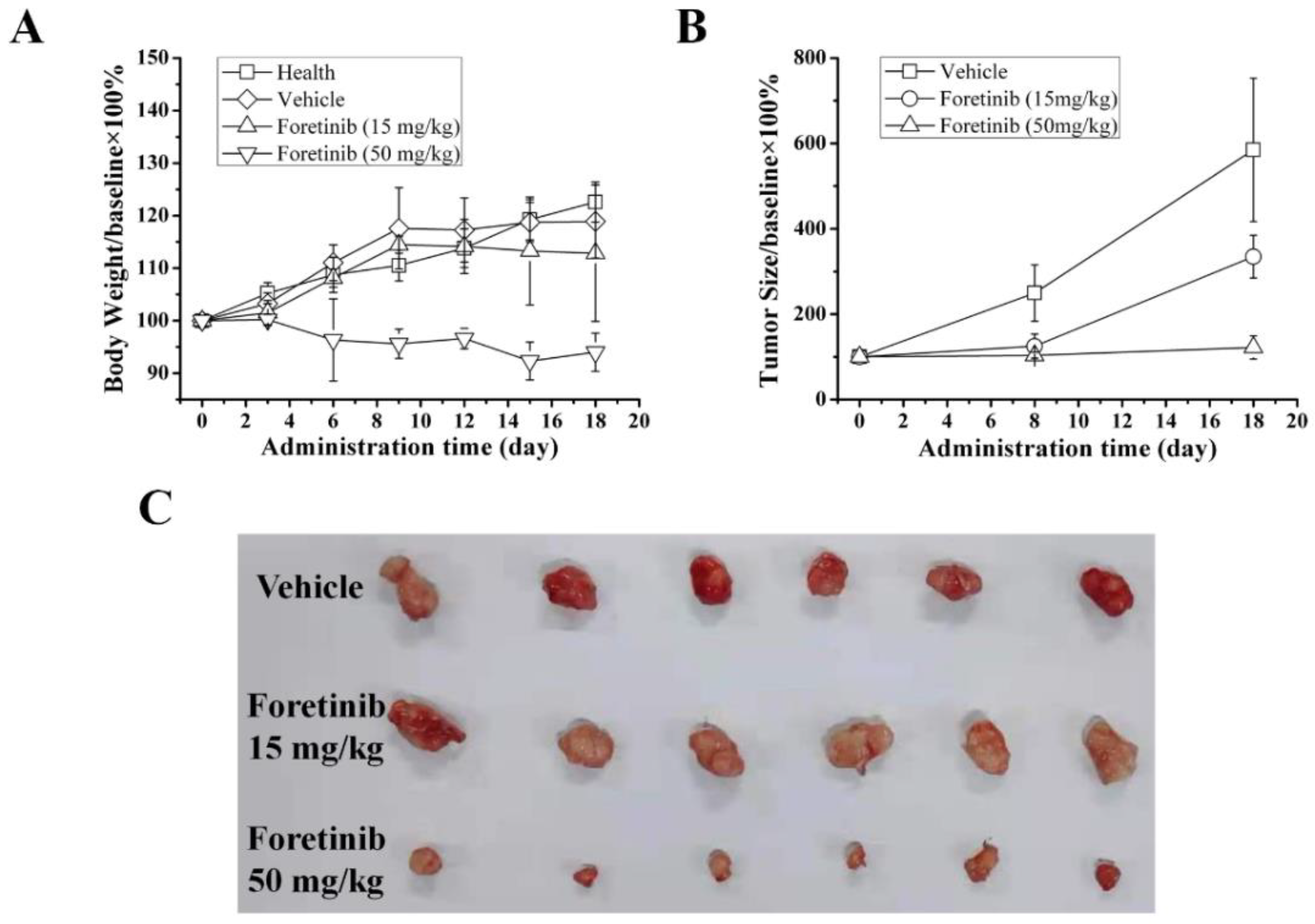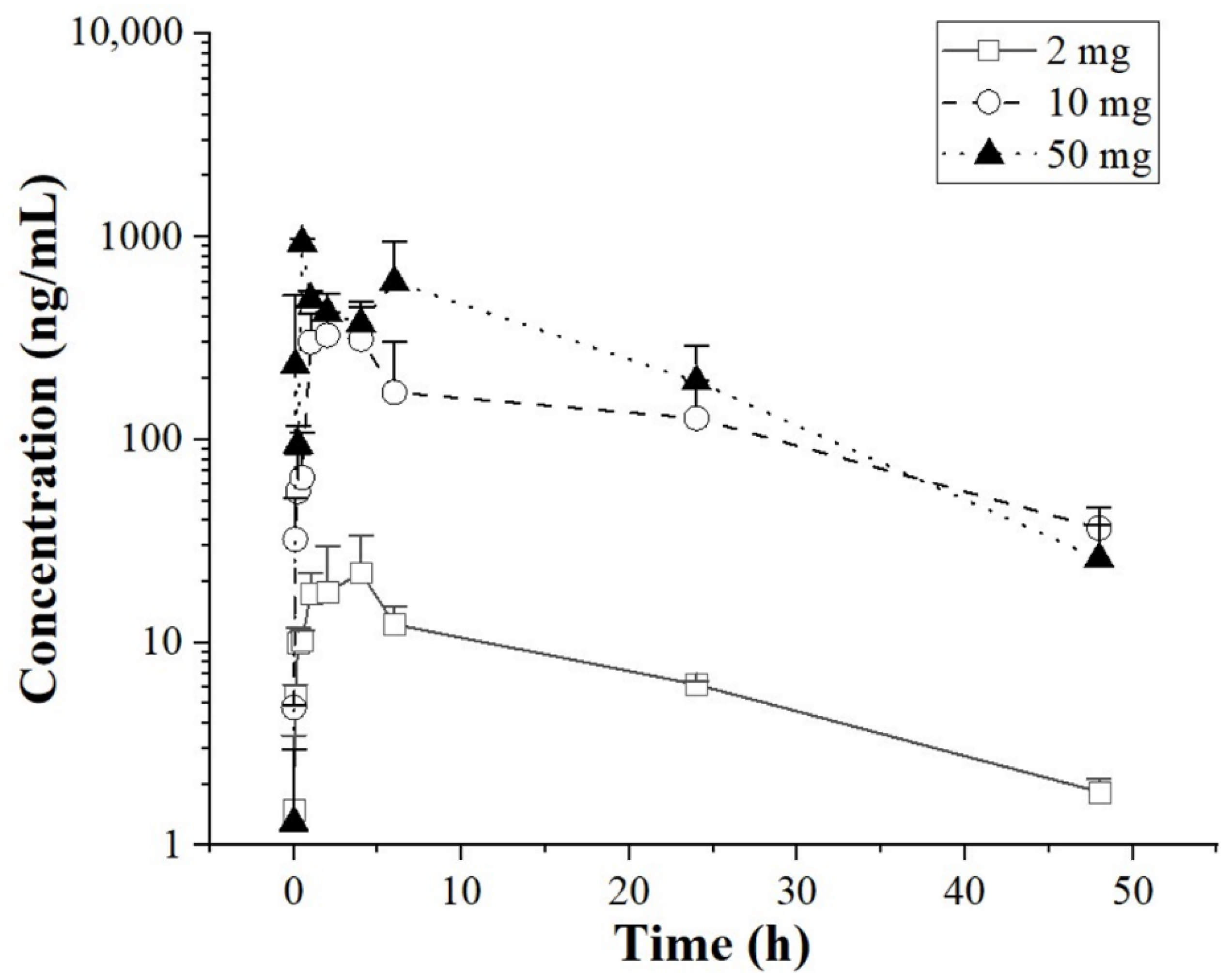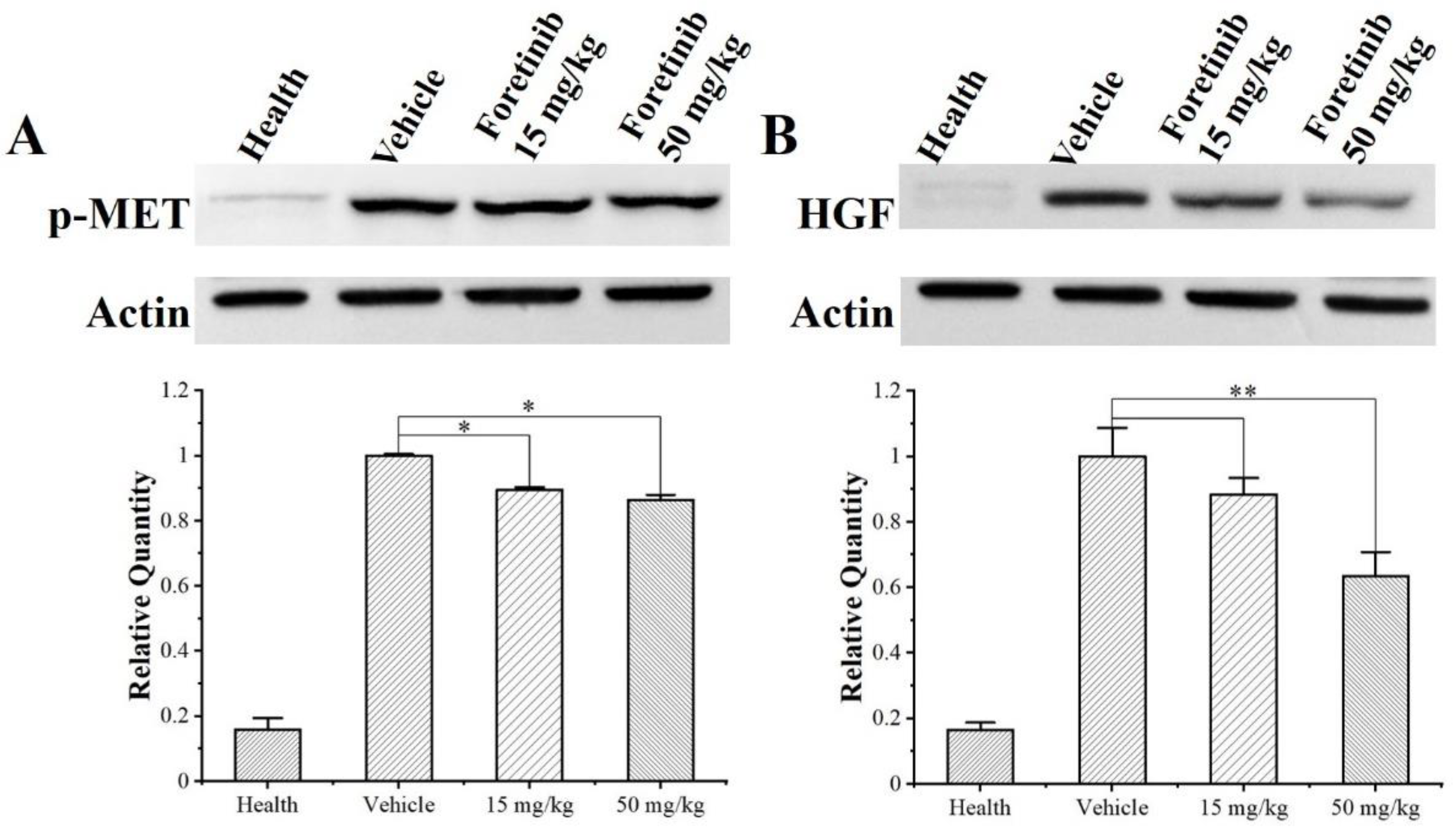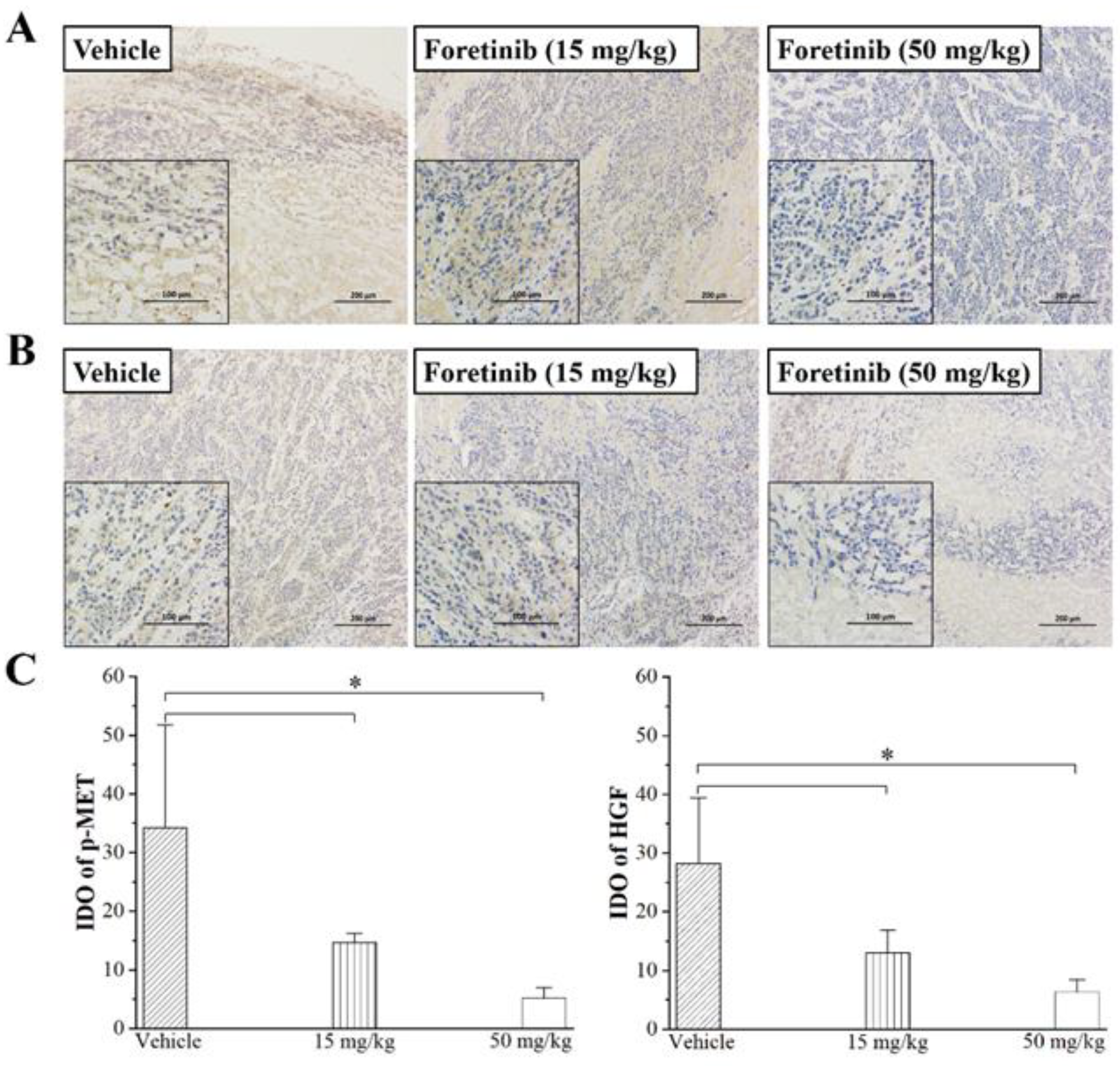Foretinib Is Effective against Triple-Negative Breast Cancer Cells MDA-MB-231 In Vitro and In Vivo by Down-Regulating p-MET/HGF Signaling
Abstract
1. Introduction
2. Results
2.1. Foretinib Inhibited the Tumor Growth of MDA-MB-231 Xenografts
2.2. Pharmacokinetic Characteristics of Foretinib In Vivo
2.3. Foretinib Significantly Inhibited p-MET In Vitro and In Vivo
3. Discussion
4. Materials and Methods
4.1. Drugs and Reagents
4.2. Cell Culture
4.3. Animals
4.4. Tumor Xenograft Model
4.5. Tumor Growth Inhibition Assay
4.6. Pharmacokinetic Study
4.7. Western Blot Analysis
4.8. Quantitative Real-Time PCR
4.9. Immunohistochemical (IHC) Staining
4.10. Statistics
Author Contributions
Funding
Institutional Review Board Statement
Informed Consent Statement
Data Availability Statement
Conflicts of Interest
References
- Rakha, E.A.; El-Sayed, M.E.; Lee, A.H.; Elston, C.W.; Grainge, M.J.; Hodi, Z.; Blamey, R.W.; Ellis, I.O. Prognostic significance of Nottingham histologic grade in invasive breast carcinoma. J. Clin. Oncol. 2008, 26, 3153–3158. [Google Scholar] [CrossRef] [PubMed]
- Rhee, J.; Han, S.W.; Oh, D.Y.; Kim, J.H.; Im, S.A.; Han, W.; Park, I.A.; Noh, D.Y.; Bang, Y.J.; Kim, T.Y. The clinicopathologic characteristics and prognostic significance of triple-negativity in node-negative breast cancer. BMC Cancer 2008, 8, 307. [Google Scholar] [CrossRef] [PubMed]
- Raghav, K.P.; Wang, W.; Liu, S.; Chavez-MacGregor, M.; Meng, X.; Hortobagyi, G.N.; Mills, G.B.; Meric-Bernstam, F.; Blumenschein, G.R., Jr.; Gonzalez-Angulo, A.M. cMET and phospho-cMET protein levels in breast cancers and survival outcomes. Clin. Cancer Res. 2012, 18, 2269–2277. [Google Scholar] [CrossRef] [PubMed]
- Kim, Y.J.; Choi, J.-S.; Seo, J.; Song, J.-Y.; Eun Lee, S.; Kwon, M.J.; Kwon, M.J.; Kundu, J.; Jung, K.; Oh, E.; et al. MET is a potential target for use in combination therapy with EGFR inhibition in triple-negative/basal-like breast cancer. Int. J. Cancer 2014, 134, 2424–2436. [Google Scholar] [CrossRef] [PubMed]
- Mueller, K.L.; Yang, Z.Q.; Haddad, R.; Ethier, S.P.; Boerner, J.L. EGFR/Met association regulates EGFR TKI resistance in breast cancer. J. Mol. Signal. 2010, 5, 8. [Google Scholar] [CrossRef] [PubMed]
- Birchmeier, C.; Birchmeier, W.; Gherardi, E.; Vande Woude, G.F. Met, metastasis, motility and more. Nat. Rev. Mol. Cell Biol. 2003, 4, 915–925. [Google Scholar] [CrossRef] [PubMed]
- Ortiz-Zapater, E.; Lee, R.W.; Owen, W.; Weitsman, G.; Fruhwirth, G.; Dunn, R.G.; Neat, M.J.; McCaughan, F.; Parker, P.; Ng, T.; et al. MET-EGFR dimerization in lung adenocarcinoma is dependent on EGFR mtations and altered by MET kinase inhibition. PLoS ONE 2017, 12, e0170798. [Google Scholar] [CrossRef] [PubMed]
- Comoglio, P.M.; Giordano, S.; Trusolino, L. Drug development of MET inhibitors: Targeting oncogene addiction and expedience. Nat. Rev. Drug Discov. 2008, 7, 504–516. [Google Scholar] [CrossRef] [PubMed]
- Parikh, P.K.; Ghate, M.D. Recent advances in the discovery of small molecule c-Met Kinase inhibitors. Eur. J. Med. Chem. 2018, 143, 1103–1138. [Google Scholar] [CrossRef] [PubMed]
- Ferreira, L.G.; Andricopulo, A.D. From Protein Structure to Small-Molecules: Recent Advances and Applications to Fragment-Based Drug Discovery. Curr. Top. Med. Chem. 2017, 17, 2260–2270. [Google Scholar] [CrossRef] [PubMed]
- Yau, T.C.C.; Lencioni, R.; Sukeepaisarnjaroen, W.; Chao, Y.; Yen, C.-J.; Lausoontornsiri, W.; Chen, P.-J.; Sanpajit, T.; Camp, A.; Cox, D.S.; et al. A Phase I/II Multicenter Study of Single-Agent Foretinib as First-Line Therapy in Patients with Advanced Hepatocellular Carcinoma. Clin. Cancer Res. 2017, 23, 2405–2413. [Google Scholar] [CrossRef] [PubMed]
- Huynh, H.; Ong, R.; Soo, K.C. Foretinib demonstrates anti-tumor activity and improves overall survival in preclinical models of hepatocellular carcinoma. Angiogenesis 2011, 15, 59–70. [Google Scholar] [CrossRef] [PubMed]
- Logan, T.F. Foretinib (XL880): C-MET Inhibitor with Activity in Papillary Renal Cell Cancer. Curr. Oncol. Rep. 2013, 15, 83–90. [Google Scholar] [CrossRef] [PubMed]
- Zillhardt, M.; Park, S.-M.; Romero, I.L.; Sawada, K.; Montag, A.; Krausz, T.; Yamada, S.D.; Peter, M.E.; Lengyel, E. Foretinib (GSK1363089), an Orally Available Multikinase Inhibitor of c-Met and VEGFR-2, Blocks Proliferation, Induces Anoikis, and Impairs Ovarian Cancer Metastasis. Clin. Cancer Res. 2011, 17, 4042–4051. [Google Scholar] [CrossRef] [PubMed]
- Chen, H.M.; Tsai, C.H.; Hung, W.C. Foretinib inhibits angiogenesis, lymphangiogenesis and tumor growth of pancreatic cancer in vivo by decreasing VEGFR-2/3 and TIE-2 signaling. Oncotarget 2015, 6, 14940–14952. [Google Scholar] [CrossRef] [PubMed]
- Ji, X.W.; Zheng, B.; Cui, Y.M. Antitumor effect and mechanism of foretinib on triple negative breast cancer cells MDA-MB-231. Chin. J. Clin. Pharmacol. 2021, 37, 2640–2643. [Google Scholar]
- Simiczyjew, A.; Dratkiewicz, E.; Van Troys, M.; Ampe, C.; Styczen, I.; Nowak, D. Combination of EGFR Inhibitor Lapatinib and MET Inhibitor Foretinib Inhibits Migration of Triple Negative Breast Cancer Cell Lines. Cancers 2018, 10, 335. [Google Scholar] [CrossRef] [PubMed]
- Guo, A.; Villen, J.; Kornhauser, J.; Lee, K.A.; Stokes, M.P.; Rikova, K.; Possemato, A.; Nardone, J.; Innocenti, G.; Wetzel, R.; et al. Signaling networks assembled by oncogenic EGFR and c-Met. Proc. Natl. Acad. Sci. USA 2008, 105, 692–697. [Google Scholar] [CrossRef] [PubMed]
- Linklater, E.S.; Tovar, E.A.; Essenburg, C.J.; Turner, L.; Madaj, Z.; Winn, M.E.; Melnik, M.K.; Korkaya, H.; Maroun, C.R.; Christensen, J.G.; et al. Targeting MET and EGFR crosstalk signaling in triple-negative breast cancers. Oncotarget 2016, 7, 69903–69915. [Google Scholar] [CrossRef] [PubMed]
- Ji, X.W.; Kang, Z.S.; Cui, Y.M. Determination the concentration of Foretinib in mice plasma by LC-MS/MS. Chin. J. Clin. Pharmacol. 2021, 37, 3165–3168. [Google Scholar]





| Parameters * | Foretinib | ||
|---|---|---|---|
| Dose (mg/kg) | 2 | 10 | 50 |
| T1/2 (h) | 15.09 ± 2.49 | 19.95 ± 6.72 | 9.48 ± 0.045 |
| Tmax (h) | 4 | 2 | 0.5 |
| Cmax (ng/mL) | 22.25 ± 11.24 | 334.00 ± 107.48 | 1434.00 ± 743.88 |
| k (1/h) | 0.046 ± 0.008 | 0.037 ± 0.012 | 0.073 ± 0.0003 |
| Vd (L/kg) | 109.72 ± 34.73 | 39.76 ± 13.95 | 60.90 ± 31.53 |
| AUC0–t (μg·h/L) | 366.29 ± 76.42 | 6207.91 ± 423.10 | 12,633.22 ± 6499.58 |
| AUC0–∞ (μg·h/L) | 406.88 ± 63.35 | 7257.16 ± 108.13 | 12,988.54 ± 6777.58 |
| MRT (h) | 20.13 ± 5.05 | 25.06 ± 8.36 | 13.31 ± 0.73 |
Disclaimer/Publisher’s Note: The statements, opinions and data contained in all publications are solely those of the individual author(s) and contributor(s) and not of MDPI and/or the editor(s). MDPI and/or the editor(s) disclaim responsibility for any injury to people or property resulting from any ideas, methods, instructions or products referred to in the content. |
© 2023 by the authors. Licensee MDPI, Basel, Switzerland. This article is an open access article distributed under the terms and conditions of the Creative Commons Attribution (CC BY) license (https://creativecommons.org/licenses/by/4.0/).
Share and Cite
Ji, X.; Meng, X.; He, Q.; Xiang, X.; Shi, Y.; Zhu, X. Foretinib Is Effective against Triple-Negative Breast Cancer Cells MDA-MB-231 In Vitro and In Vivo by Down-Regulating p-MET/HGF Signaling. Int. J. Mol. Sci. 2023, 24, 757. https://doi.org/10.3390/ijms24010757
Ji X, Meng X, He Q, Xiang X, Shi Y, Zhu X. Foretinib Is Effective against Triple-Negative Breast Cancer Cells MDA-MB-231 In Vitro and In Vivo by Down-Regulating p-MET/HGF Signaling. International Journal of Molecular Sciences. 2023; 24(1):757. https://doi.org/10.3390/ijms24010757
Chicago/Turabian StyleJi, Xiwei, Xiangrui Meng, Qingfeng He, Xiaoqiang Xiang, Yufei Shi, and Xiao Zhu. 2023. "Foretinib Is Effective against Triple-Negative Breast Cancer Cells MDA-MB-231 In Vitro and In Vivo by Down-Regulating p-MET/HGF Signaling" International Journal of Molecular Sciences 24, no. 1: 757. https://doi.org/10.3390/ijms24010757
APA StyleJi, X., Meng, X., He, Q., Xiang, X., Shi, Y., & Zhu, X. (2023). Foretinib Is Effective against Triple-Negative Breast Cancer Cells MDA-MB-231 In Vitro and In Vivo by Down-Regulating p-MET/HGF Signaling. International Journal of Molecular Sciences, 24(1), 757. https://doi.org/10.3390/ijms24010757






